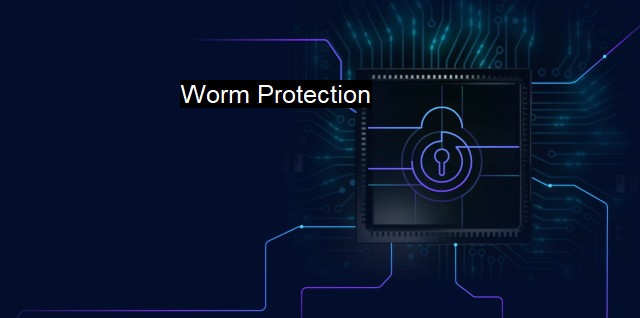What is Worm Protection?
Advancing Internet Security: Understanding Worm Protection and its Role in Fighting Malware
Worm protection refers to defensive mechanisms executed by a cybersecurity system that are specifically designed to guard against computer worms. A worm, in cybersecurity terms, is a type of malicious software (malware) that replicates itself to spread to other computers without any user intervention. They frequently spread over network connections and exploit vulnerabilities or loopholes in an operating system or a piece of software. Worms are dangerous because they can autonomously propagate themselves, lead to a significant abuse of network resources, and ultimately result in the disruption of system functionality.To clearly understand the concept of worm protection, one must first grasp the nature of computer worms as distinct from other types of malware. Normally, viruses require host programs or files to infect and spread, and Trojan horses masquerade as harmless applications but damage systems once activated. Unlike these, computer worms stand out for their self-replicating ability without the need for human interaction— such as clicking a suspicious link or opening a corrupted file. Once a single worm enters an unprotected system, it can multiply and spread swiftly, causing extensive damage including the degradation of system performance, the unauthorized consumption of bandwidth, the theft of sensitive information, or the rendering of a computer or network inoperable via a Denial-of-Service (DoS) attack.
Worm protection, therefore, operates to detect, block, and eliminate these menacing cyber entities. Deploying techniques such as signature-based detection, behavior monitoring, and heuristics, anti-worm systems thwart attempts by worms to penetrate and wreak havoc on a computer or network.
Signature-based detection involves checking files and software against a database of known malware signatures, or digital fingerprints. If any traces of a known worm signature are detected in a system, the security software moves to quarantine or remove it. While this method generally provides effective protection against known worms, it struggles against new, unidentified worms – commonly referred to as zero-day threats.
Behavior monitoring, on the other hand, is a dynamic mode of worm protection wherein software monitors system activity in real time, pinpointing and restricting any activity that bears resemblance to malicious behavior common of worms. This method, combined with heuristics, which relies on the principle of learning from past patterns and experiences, can successfully counter zero-day threats. By spotting suspicious behavioral patterns or by comparing activities with learned malicious patterns, a worm can be identified and tackled before it inflicts damage.
Impressive as worm protection may sound, it does still have its limitations dominatingly stemming from the ever-evolving nature of malware. Cyber criminals are continuously craftsmanship sophisticated worms designed to bypass or deceive protection mechanisms. Thus, it is critical to always keep antivirus or anti-malware software and system patches updated. Maintaining an up-to-date system enables it to guard against even recent threats.
Worm protection does not render an individual or organization immune to all cyber threats; it dampens the severity of threats posed by worms and aids in maintaining the health of digital environments. Comprehensive cybersecurity seeks integration of worm protection as a fragment of a broader protection strategy— a strategy that incorporates the identification and correction of system vulnerabilities, the cultivation of safe user habits, the frequent backing up of valuable data, and disinfection processes after any worm attack.
Data breaches and malicious cyber activities continue to rise, making worm protection, and by extension intricate cybersecurity practices, more necessary than ever. So, an understanding and application of worm protection should sit nicely alongside the wider essence of cybersecurity because, after all, prevention is better than cure. In order to safeguard personal, business, or any other valuable data, worm protection is one essential facet under the umbrella of cybersecurity and antivirus protection that must be duly considered to guarantee a robust defense system.

Worm Protection FAQs
What is worm protection?
Worm protection is a cybersecurity feature that helps prevent worms from infecting a computer or network. Worms are a type of malware that can self-replicate and spread quickly, causing widespread damage.How does worm protection work?
Worm protection works by monitoring networks and devices for suspicious activity and blocking or quarantining any potential threats. It often uses signature-based detection, behavioral analysis, and other advanced techniques to identify and stop worms in their tracks.Why is worm protection important?
Worm protection is important because worms can cause significant damage to computer systems and networks, including data loss, system crashes, and unauthorized access. Without proper protection, worms can spread rapidly and wreak havoc on organizations of all sizes.Is worm protection included in antivirus software?
Yes, many antivirus software programs include worm protection as a standard feature. However, it's important to check the specific features and capabilities of any antivirus software before purchasing to ensure that it offers comprehensive protection against worms and other types of malware.| | A | | | B | | | C | | | D | | | E | | | F | | | G | | | H | | | I | | | J | | | K | | | L | | | M | |
| | N | | | O | | | P | | | Q | | | R | | | S | | | T | | | U | | | V | | | W | | | X | | | Y | | | Z | |
| | 1 | | | 2 | | | 3 | | | 4 | | | 7 | | | 8 | | |||||||